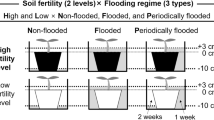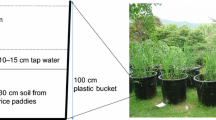Abstract
Persicaria thunbergii is a representative annual herb in Korean wetlands, widely inhabits not only in lentic wetlands, but also in unstable riparian wetlands. To better understand the occupational strategy of this plant, we investigated environment, growth characteristics before and after harsh flooding disturbance in FDA (flooding disturbed area) and NDA (non-disturbed area). Water level, fresh soil moisture and organic matter of NDA were significantly higher than FDA. Before flooding disturbance, plant height, individual length, number of node, individual biomass and biomass per 1 m2 were significantly higher in FDA than in NDA. After flooding disturbance, plant height, biomass per 1 m2, coverage and relative coverage were significantly lower in FDA than in NDA, yet individual length, number of node, individual biomass and aerial seed production were not different. In FDA, creeping stems survive despite a flooding disturbance because they are parallel with the water flow and are firmly fixed to the ground through numerous adventitious roots. Surviving creeping stems make new shoots rapidly and P. thunbergii recovers its biomass during less than a month. Every regenerated shoots make reproductive organs. Thus, P. thunbergii can reproduce and successfully survive the next generation in the riparian habitat despite the harsh flooding disturbance every year.
Similar content being viewed by others
References
Ahn YH, Song JS (2003) Occurrence of streamside flora in relation to environmental condition at Ansungchon creek. Korean J Environ Sci 12:573–582 (in Korean)
Blom CWPM, Voesenek LACJ (1996) Flooding: the survival strategies of plants. TREE 11:290–295
Blom CWPM, Bögemann GM, Laan P, van der Sman AJM, van de Steeg HM, Voesenek LACJ (1990) Adaptations to flooding in plants from river areas. Aquat Bot 38:29–47
Carter MF, Grace JB (1990) Relationships between flooding tolerance, life history, and short-term competitive performance in three species of Polygonum. Amer J Bot 77:381–387
Cho DS (1995) A study on the distribution of streamside vegetation in kyonganchon. Korean J Ecol 18:55–62 (in Korean)
Cho HJ, Cho KH (2005) Responses of riparian vegetation to flooding disturbance in a sand stream. KSCE J of Civ Eng 9:49–53
DeBell DS, Naylor AW (1972) Some factors affecting germination of swamp tupelo seeds. Ecology 53:504–506
Kamphake LJ, Hannah SA, Cohen JM (1967) Automated analysis for nitrate by hydrazine reduction. Water Res 1:205–216
Kang SJ, Kwak AK (1998) Changes of riparian vegetation in relation to disturbance of Musim-chon Stream, Cheongju. Korean J Ecol 21:435–448 (in Korean)
Kawano S (2008) Life-history monographs of Japanese plants. 11: Polygonum thunbergii Sieb. et Zucc. (Polygonaceae). Plant Spec Biol 23:222–227
Keddy PA, Ellis TH (1985) Seedling recruitment of 11 wetland plant species along a water level gradient: shared or distinct responses? Can J Bot 63:1876–1879
Keddy PA, Reznicek AA (1986) Great lakes vegetation dynamics: the role of fluctuating water levels and buried seeds. J Great Lakes Res 12:25–36
Lee DJ, Cho JS, Kuk YI, Ahn HG (2003) Water quality of streams and riparian vegetation at rice cultivation area of eastern Jeonnam. Korean J Environ Agric 22:7–15 (in Korean)
Lee KB, Kim CH, Lee DB, Kim JG, Park CW (2004) The flora and vegetation of the Dongjin River. Korean J Environ Agric 23:34–40 (in Korean)
Mitchell RS (1976) Submergence experiments on nine species of semi-aquatic Polygonum. Amer J Bot 63:1158–1165
Murphy J, Riley JP (1962) A modified single solution method for the determination of phosphate in natural waters. Anal Chim Acta 27:31–36
Naiman RJ, Decamps H (1997) The ecology of interfaces: Riparian zones. Annu Rev Ecol Syst 28:621–658
Nishihiro J, Araki S, Fujiwara N, Washitani I (2004) Germination characteristics of lakeshore plants under an artificially stabilized water regime. Aquat Bot 79:333–343
Oh YJ, Sohn SI, Kim CS, Kim BW, Kang BH (2008) Phytosociological classification of vegetation in paddy levee. Korean J Environ Agric 27:413–420 (in Korean)
Oh YJ, Lee BM, Sohn SI, Lee YK, Nam HS, Lee SB, Kang CK, Jee HJ (2010) Vegetation types and soil environment as affected by fallow paddy Korean. J Weed Sci 30:405–411 (in Korean)
Park IH, Jang GS, Cho KJ, Ra JH (2009) Analysis on the flora and vegetation for ecological restoration of local stream — in case of local streams in Namwon —. J Korean Env Res Tech 12:153–163 (in Korean)
Rejmankova E (2011) The role of macrophytes in wetland ecosystems. J Ecol Field Biol 34:333–345
Resh VH, Brown AV, Covich AP, Gurtz ME, Li HW, Minshall GW, Reice SR, Sheldon AL, Wallace JB, Wissmar RC (1988) The role of disturbance in stream ecology. J N Am Benthol Soc 7:433–455
Sheldrick BH, Wang C (1993) Particle size distribution. In: Soil sampling and methods of analysis (Carter MR, ed). Lewis, Boca Raton, FL, pp 499–511
Solorzano L (1969) Determination of ammonia in natural waters by the phenolhypochlorite method. Limnol Oceanogr 14:799–801
Song JS, Song SD (1996) A phytosociological study on the riverside vegetation around Hanchon, and upper stream of Nak-tong River. Korean J Ecol 19:431–451 (in Korean)
Yun KS (2007) Soil and vegetation characteristics of abandoned paddy field. J Korean Assoc Regional Geogr 13:129–142 (in Korean)
Author information
Authors and Affiliations
Corresponding author
Rights and permissions
About this article
Cite this article
Kim, D.H., Choi, H. & Kim, J.G. Occupational strategy of Persicaria thunbergii in riparian area: Rapid recovery after harsh flooding disturbance. J. Plant Biol. 55, 226–232 (2012). https://doi.org/10.1007/s12374-011-0298-6
Received:
Accepted:
Published:
Issue Date:
DOI: https://doi.org/10.1007/s12374-011-0298-6




